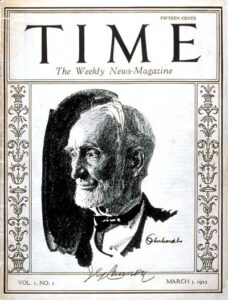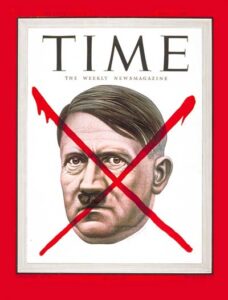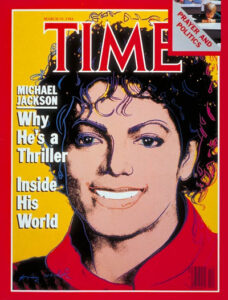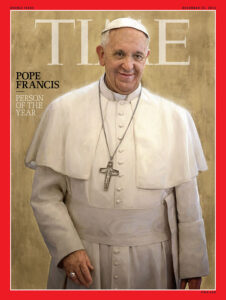100 years ago, when the phenomenon known as “The Roaring Twenties” was just beginning to exist in the United States, TIME Magazine started to be published, and thanks to its continuous work during the last century, it is now the oldest weekly magazine in the country.
In celebration of its centenary, we took a journey through its history, the features that made it unique, and those milestones that have transformed it into a global benchmark in communications. Likewise, we took the liberty, as the team of Casa Museo EFM, to make our own selection of the 10 covers that we considered the most emblematic of these 100 years.
In 1922, two journalists born in 1898 and graduated from Yale University in 1920, founded the publishing company TIME Inc. Briton Hadden and Henry Luce, both passionate about journalism, joined forces, and created a unique weekly newspaper with an informative purpose, but in a more relaxed and informal style that characterizes it to this day.
TIME Magazine, throughout a century of existence, has covered the most relevant events in the West and has served as a beacon of information like few other media outlets in the world. The fact that a person appears on the cover of TIME Magazine means that its editors took on the challenge of researching and publishing what that person means to the globe. If a politician, a queen, a singer, or an astronaut appears on the cover of TIME, this means that his or her figure and legacy will be remembered for posterity, since he or she has left a mark of relevance, scope, and global impact.
It is worth saying that TIME, as a brand, has withstood the passage of time and the irruption of new technologies and social networks, and has remained strong despite the decline of print journalism and the media crisis.
On the occasion of TIME magazine’s 100th anniversary, in this article we took a look at its history, the features that made it unique, and the milestones that have transformed it into a global benchmark in communications. Likewise, we resolved to make our own selection of the 10 covers that we considered most emblematic during its period of existence.
The first issue of TIME Magazine was published on Saturday, March 3rd, 1923. Unlike its typical red-framed cover that we now know, during its early years it featured a simple black-and-white cover with the publication’s name at the top, and a portrait, in most cases illustrated, framed on the sides by columns of plant designs.[1]
The protagonist of its first cover was the Republican Congressman Joseph Gurney Cannon, who at the time announced his retirement from public life after 23 terms in the U.S. House of Representatives. At the age of 86, “Uncle Joseph”, as he was called by the magazine, left behind an influential career thanks to which he appeared in this first issue of TIME, portrayed by artist-illustrator Willian Oberhardt.[2]
A couple of years after its first publication, TIME adopted the characteristic red frame on its cover: this is an aesthetic hallmark included in 1927 which the magazine maintains to this day and that was only replaced by a black one as a sign of mourning in a special issue dedicated to the attacks of September 11th, 2001.
At the end of 1927, the magazine began the election of what was initially called “Man of the Year”, to highlight various relevant male figures from around the world thanks to their influence or participation in important events in the political, economic, cultural, or social spheres. This election still exists; it is an annual event that is eagerly awaited by the community. However, circumstances and changes in society meant that little by little the need to highlight female figures arose, so at the end of the century, the name of this acknowledgment was changed to “Person of the Year”. In those days, TIME awarded Albert Einstein as “Person of the Century” in its special issue of December 31st, 1999.[3]
To celebrate its 100 years of history, the magazine made a retrospective of the road traveled so far through a special publication for its centenary and the programming of different celebratory activities.[4]
As for us, we decided to select and share with you a selection of ten covers, one for each decade of existence, we believe that they deserve to be remembered by all; each of them tells a story and transports us to different events that marked a century of weekly publications and special issues of TIME Magazine.
 To remember the first decade of the magazine’s existence, we decided to choose the cover with which it began its circulation in 1923. Its protagonist was the octogenarian politician Joseph Gurney Cannon, above mentioned. This issue marked the beginning of an aesthetic tradition that would continue for many years. Its cover hides an interesting story because, according to research, this was the only portrait of the politician that existed to date, and it was created by an artist at the request of the U.S. government. This fact gives this cover an undeniable value.[5]
To remember the first decade of the magazine’s existence, we decided to choose the cover with which it began its circulation in 1923. Its protagonist was the octogenarian politician Joseph Gurney Cannon, above mentioned. This issue marked the beginning of an aesthetic tradition that would continue for many years. Its cover hides an interesting story because, according to research, this was the only portrait of the politician that existed to date, and it was created by an artist at the request of the U.S. government. This fact gives this cover an undeniable value.[5]
The 1930s were marked by economic recovery efforts in Europe and America after the Great Depression of 1929. At that time, Italy and Germany witnessed the rise of strong governmental regimes that, in the middle of the decade, consolidated totalitarian policies and led the world into a second war at the end of this period. However, in the early part of the decade, the situation was quite different. The United States and Italy maintained close relations that were reflected, for example, in the support given to the feat of the protagonist of our second cover, air pilot Italo Balbo, who in mid-1933 made a transatlantic flight at the helm of some twenty seaplanes. For this reason, TIME dedicated its cover of June 26 of that year to this distinguished aviation character and gave details of his expedition in one of its sections.[6]
 The first half of the 1940s was strongly influenced by World War II, but its consequences were felt for a long time. It defined political and economic relations between countries and determined the destiny of societies. Prominent figures were deeply ingrained in the history of mankind. One of them was Adolf Hitler, leader of Nazi Germany and the first of a series of people who appeared in TIME Magazine with their faces crossed out with an X as a sign of repudiation since they embodied all those negative attributes for peace, democracy, and human rights. This was the cover of May 7, 1945, shortly after Hitler’s fall. The magazine labeled this character as “evil,” “cruel,” and as a man of “twisted and inadequate mind”.[7]
The first half of the 1940s was strongly influenced by World War II, but its consequences were felt for a long time. It defined political and economic relations between countries and determined the destiny of societies. Prominent figures were deeply ingrained in the history of mankind. One of them was Adolf Hitler, leader of Nazi Germany and the first of a series of people who appeared in TIME Magazine with their faces crossed out with an X as a sign of repudiation since they embodied all those negative attributes for peace, democracy, and human rights. This was the cover of May 7, 1945, shortly after Hitler’s fall. The magazine labeled this character as “evil,” “cruel,” and as a man of “twisted and inadequate mind”.[7]
 By mid-century, well into the 1950s, the figure of a woman emerged in Europe; she was Elizabeth II, who would later go down in British history as the longest-reigning monarch and ruler of the longest reign. After the death of her father in 1952, she assumed the position of queen and was chosen by TIME as Woman of the Year. This news was quite controversial, as this acknowledgment was traditionally given only to men. The publication of the cover with her portrait took place on January 5th, 1953. In this same year, her coronation also took place, just a couple of months after this acknowledgment.[8]
By mid-century, well into the 1950s, the figure of a woman emerged in Europe; she was Elizabeth II, who would later go down in British history as the longest-reigning monarch and ruler of the longest reign. After the death of her father in 1952, she assumed the position of queen and was chosen by TIME as Woman of the Year. This news was quite controversial, as this acknowledgment was traditionally given only to men. The publication of the cover with her portrait took place on January 5th, 1953. In this same year, her coronation also took place, just a couple of months after this acknowledgment.[8]
The 1960s was a revolutionary decade in many aspects, especially due to the beginning of the Cold War. One of the areas in which humanity experienced amazing milestones was in the scientific/technological field, especially in everything related to space exploration. This objective particularly obsessed the great powers of the time, as it was a way of demonstrating their mightiness. The United States and the Soviet Union invested a great amount of economic and human resources in the so-called “space race”. In 1969, the U.S. space agency achieved its ambitious project to reach the Moon, which had been announced at the beginning of the decade by the late President Kennedy. At that time, Neil Armstrong became a true world icon by carrying out one of the greatest feats of humanity: being the first man to set foot on our natural satellite. It is for this reason that we chose this cover belonging to the decade of the 60’s as the most important from that period; it was published on July 25th, 1969.[9]
 On September 11th, 1973, a coup d’état overthrew the government of Chilean President Salvador Allende. This event marked the beginning of a military dictatorship in our country that lasted until the late 1980s, and left marks on society that persist to this day. In the context of the ideological conflict between the United States and the Soviet Union, the Chilean socialist government represented a threat to the pretensions of the northern country, which wanted to maintain its influence over Latin America. This is why the abrupt end of the existing Chilean government meant a real triumph for U.S. hegemony. TIME Magazine covered everything related to this news. Its cover on September 24, 1973 illustrated the late Chilean president splattered with red stains; whether these are blood or simply paint is left to personal interpretation. The Chilean Government Building called La Moneda can also be seen in the background, crowned with the hammer and sickle and the phrase “After the fall” in one corner[10]. On its pages, there is a detailed article on Allende’s course during his presidency as well as a description of what happened during September 11. And a sharp criticism of the complex situation that the continent was going through due to the military interventions, supported by the United States, which at that time affected the lives of 70% of the inhabitants of South America.[11]
On September 11th, 1973, a coup d’état overthrew the government of Chilean President Salvador Allende. This event marked the beginning of a military dictatorship in our country that lasted until the late 1980s, and left marks on society that persist to this day. In the context of the ideological conflict between the United States and the Soviet Union, the Chilean socialist government represented a threat to the pretensions of the northern country, which wanted to maintain its influence over Latin America. This is why the abrupt end of the existing Chilean government meant a real triumph for U.S. hegemony. TIME Magazine covered everything related to this news. Its cover on September 24, 1973 illustrated the late Chilean president splattered with red stains; whether these are blood or simply paint is left to personal interpretation. The Chilean Government Building called La Moneda can also be seen in the background, crowned with the hammer and sickle and the phrase “After the fall” in one corner[10]. On its pages, there is a detailed article on Allende’s course during his presidency as well as a description of what happened during September 11. And a sharp criticism of the complex situation that the continent was going through due to the military interventions, supported by the United States, which at that time affected the lives of 70% of the inhabitants of South America.[11]
 And so, we come to our cover choice for the 1980s, a time when the most influential pop icon of the 20th century, Michael Jackson, achieved success. His album Thriller was released in late 1982 and quickly affected the entertainment industry and it was a big hit at the famous Grammy Awards in February 1984. This album became the soundtrack in the lives of many of us. TIME dedicated its cover of March 12, 1984 to Michael Jackson with no more and no less than an illustration by another pop icon, artist Andy Warhol; this issue sold millions of copies and set records never seen before in many rankings. The magazine dedicated several of its pages to talk about the talent of the 20-year-old, the impact of his music, his charisma as an artist, and those dance steps that conquered millions of people around the world.[12]
And so, we come to our cover choice for the 1980s, a time when the most influential pop icon of the 20th century, Michael Jackson, achieved success. His album Thriller was released in late 1982 and quickly affected the entertainment industry and it was a big hit at the famous Grammy Awards in February 1984. This album became the soundtrack in the lives of many of us. TIME dedicated its cover of March 12, 1984 to Michael Jackson with no more and no less than an illustration by another pop icon, artist Andy Warhol; this issue sold millions of copies and set records never seen before in many rankings. The magazine dedicated several of its pages to talk about the talent of the 20-year-old, the impact of his music, his charisma as an artist, and those dance steps that conquered millions of people around the world.[12]
 At the end of the century, precisely in mid-1997, Diana of Wales, one of the most famous women of that time, died tragically in a car accident in France. This event shocked the world, both for her abrupt end and the personal circumstances that marked the last years of her life. After her funeral, on September 15, TIME dedicated an entire special issue to this iconic woman with one of its most remembered covers: a close-up photo of her face with a sad expression in black and white.[13]
At the end of the century, precisely in mid-1997, Diana of Wales, one of the most famous women of that time, died tragically in a car accident in France. This event shocked the world, both for her abrupt end and the personal circumstances that marked the last years of her life. After her funeral, on September 15, TIME dedicated an entire special issue to this iconic woman with one of its most remembered covers: a close-up photo of her face with a sad expression in black and white.[13]
 Shortly after the beginning of the new millennium, one of the most tragic episodes in world history took place, specifically on September 11th, 2001, in the United States. Those of us watching on live television understood little of the situation: one of the towers of the World Trade Center in New York was on fire after a plane crashed into it. Then another aircraft collided with the adjacent tower. This shocking image was captured by Lyle Owerko before the collapse of the towers and became one of the most famous photographs of the attacks after appearing on the cover of TIME’s September 14th special issue, just 3 days after these sad occurrences.[14]
Shortly after the beginning of the new millennium, one of the most tragic episodes in world history took place, specifically on September 11th, 2001, in the United States. Those of us watching on live television understood little of the situation: one of the towers of the World Trade Center in New York was on fire after a plane crashed into it. Then another aircraft collided with the adjacent tower. This shocking image was captured by Lyle Owerko before the collapse of the towers and became one of the most famous photographs of the attacks after appearing on the cover of TIME’s September 14th special issue, just 3 days after these sad occurrences.[14]
 In the decade of 2010, exactly at the beginning of 2013, the Argentine priest Jorge Bergolio was elected Pope; he chose the name “Francis”. All this happened after the unprecedented resignation of his predecessor. Francis then became the first South American to assume the highest office in the Catholic Church. For this reason, and for the promises of changes that the Supreme Pontiff made in his first months at the head of the Church, TIME chose him as “Person of the Year”. The last of this selection of 10 covers we have chosen to commemorate the magazine’s 100th anniversary shows Francis portrayed by artist Jason Seiler. In the photo, the so-called “people’s Pope” shows a smiling attitude and the appearance of humility that he manifested from the beginning.[15]
In the decade of 2010, exactly at the beginning of 2013, the Argentine priest Jorge Bergolio was elected Pope; he chose the name “Francis”. All this happened after the unprecedented resignation of his predecessor. Francis then became the first South American to assume the highest office in the Catholic Church. For this reason, and for the promises of changes that the Supreme Pontiff made in his first months at the head of the Church, TIME chose him as “Person of the Year”. The last of this selection of 10 covers we have chosen to commemorate the magazine’s 100th anniversary shows Francis portrayed by artist Jason Seiler. In the photo, the so-called “people’s Pope” shows a smiling attitude and the appearance of humility that he manifested from the beginning.[15]
Finally, and considering that this decade has just begun, and we do not know what the future holds, we would like to include as our last choice, by way of bonus, the significant cover of Chilean President Gabriel Boric. This issue contained an article and an interview published on TIME’s website in early September 2022. The cover exhibited the youngest president in the history of our country, photographed at the Palacio de La Moneda*. The president has the relaxing and youthful attitude that characterizes him. Undoubtedly, this is a communication milestone worth acknowledging.[16]
[1] TIME Magazine has a digital archive of its publications, this can be consulted on the magazine’s website,
[2] First issue of TIME Magazine
[3] TIME, No. 27, December 31st, 1999
[4] TIME, A century of impact. Online resource
[5] Nancy Gibbs, ‘News with attitude’: The impact of TIME´s first cover.
[6] TIME, No. 26, June 26th, 1933
[7] TIME, No. 19, May 7th, 1945
[8] TIME, No. 1, January 5th, 1953
[9] TIME, No. 4, July 25th, 1969
[10] TIME, No. 13, September 24th, 1973
[11] TIME, Chile: The bloody end of a marxist dream
[12] TIME, No. 12, March 19th, 1984
[13] TIME, No. 11, September 15th, 1997
[14] TIME, No. 12, September 14th, 2001
[15] TIME; No. 26, December 23rd, 2013
[16] TIME, Chile’s millenial president is a new kind of leftist leader, by Ciara Nugent, for the September 12-19th, 2022, double issue
Comments section is closed.
*Presidential seat of the Chilean government
Comentarios cerrados.